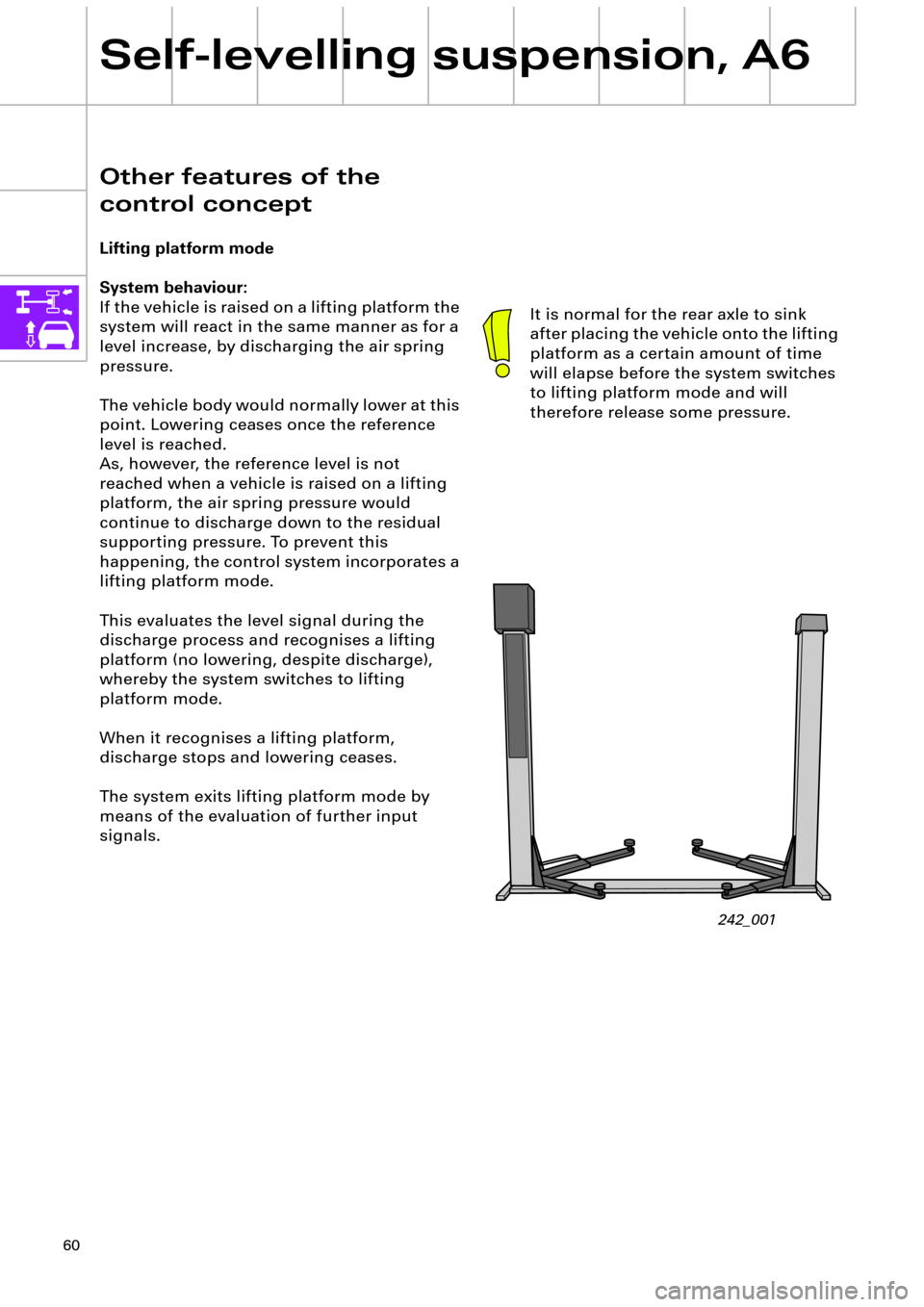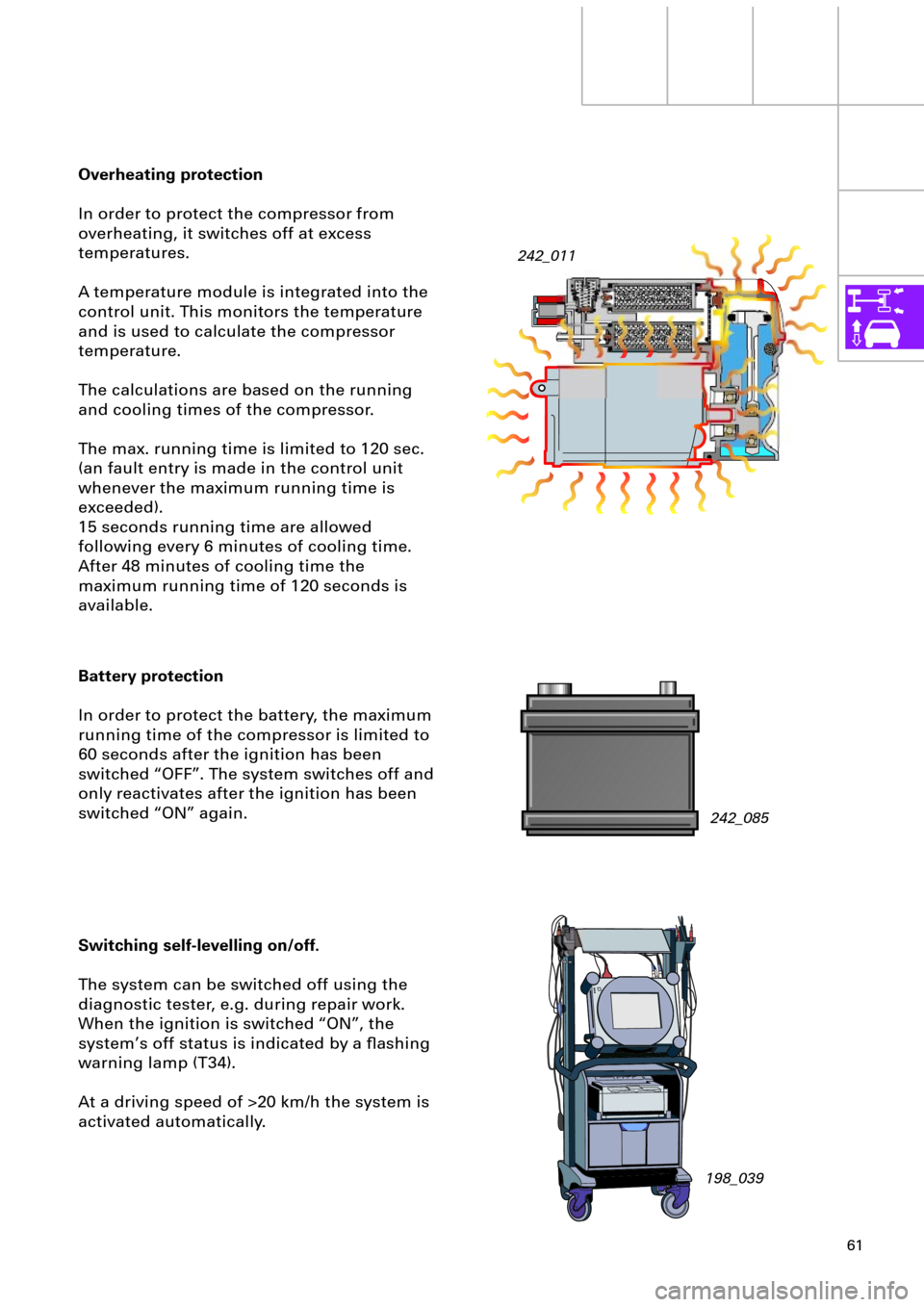Page 59 of 64

59
Sleep mode
To minimise electricity consumption the
control system switches to Òsystem idleÓ
(sleep mode) after 15 minutes.
There is no level adjustment in sleep mode.
ÒWake-upÓ is primarily triggered by the door
switch signal.
If the door switch signal fails, the system is
activated when the ignition is switched ÒONÓ
or by the driving speed signal.
The system can switch between sleep mode
and run-up mode, triggered by the door
switch signal, a maximum of 5 times. After
this, the system can only be activated via
terminal 15 and/or the driving speed signal. Run-on mode/run-up mode
After ÒIgnition OFFÓ, the control system is in
the so-called run-on/run-up mode. The
control unit remains active for a maximum of
15 minutes (via terminal 30) until it goes into
sleep mode.
The run-on/run-up mode is used to adjust
level deviations after parking the vehicle or
prior to starting on a journey.
The limit value in the rebound direction is
increased by 25 mm in the run-on/run-up
mode so that when the driver and/or the
passenger re-enters the vehicle, it does not
sink lower than the reference level or in order
to minimise any necessary vehicle raising
period.
The same response times apply as those
indicated for the stationary mode.
Page 60 of 64

60
Self-levelling suspension, A6
Other features of the
control concept
Lifting platform mode
System behaviour:
If the vehicle is raised on a lifting platform the
system will react in the same manner as for a
level increase, by discharging the air spring
pressure.
The vehicle body would normally lower at this
point. Lowering ceases once the reference
level is reached.
As, however, the reference level is not
reached when a vehicle is raised on a lifting
platform, the air spring pressure would
continue to discharge down to the residual
supporting pressure. To prevent this
happening, the control system incorporates a
lifting platform mode.
This evaluates the level signal during the
discharge process and recognises a lifting
platform (no lowering, despite discharge),
whereby the system switches to lifting
platform mode.
When it recognises a lifting platform,
discharge stops and lowering ceases.
The system exits lifting platform mode by
means of the evaluation of further input
signals.It is normal for the rear axle to sink
after placing the vehicle onto the lifting
platform as a certain amount of time
will elapse before the system switches
to lifting platform mode and will
therefore release some pressure.
242_001
Page 61 of 64

61
Overheating protection
In order to protect the compressor from
overheating, it switches off at excess
temperatures.
A temperature module is integrated into the
control unit. This monitors the temperature
and is used to calculate the compressor
temperature.
The calculations are based on the running
and cooling times of the compressor.
The max. running time is limited to 120 sec.
(an fault entry is made in the control unit
whenever the maximum running time is
exceeded).
15 seconds running time are allowed
following every 6 minutes of cooling time.
After 48 minutes of cooling time the
maximum running time of 120 seconds is
available.
242_011
Battery protection
In order to protect the battery, the maximum
running time of the compressor is limited to
60 seconds after the ignition has been
switched ÒOFFÓ. The system switches off and
only reactivates after the ignition has been
switched ÒONÓ again.
Switching self-levelling on/off.
The system can be switched off using the
diagnostic tester, e.g. during repair work.
When the ignition is switched ÒONÓ, the
systemÕs off status is indicated by a ßashing
warning lamp (T34).
At a driving speed of >20 km/h the system is
activated automatically.
198_039242_085